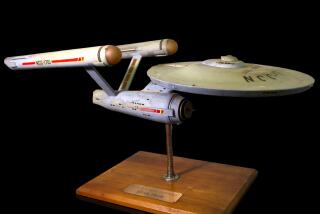How Much for ‘Beam Me Up, Scotty’?
Question: I have some original “Star Trek” scripts and was interested in learning whether they have much tradable value.--S.F.
Answer: Dealers tell us that original “Star Trek” scripts, in clean condition, can sell for about $50 each. This price, of course, depends on the popularity of a particular episode--and that’s where supply and demand would dictate the price tag.
Q: I have a Kewpie-doll collection. Who invented the Kewpie doll?--B.L.
A: Rose Cecil O’Neill, a well-known writer and artist, created the Kewpie doll. The concept first appeared in Ladies Home Journal magazine in 1909, and then, four years later, the doll itself was placed on the market.
Several manufacturers, some in Germany, have produced the doll over the years. In fact, production did not stop with O’Neill’s death in 1944.
We won’t begin to price them, because so much depends on condition. We’ve seen them listed in dealer catalogues at several hundred dollars each.
There is an International Rose O’Neill Club, P.O. Box 688, Branson, Mo. 65616.
Q: I’m a tool collector and I’d like to know how far back I can trace some ancient saws in my collection.--J.D.
A: Historians claim that the saw concept was used by the Greeks before 1000 BC. Archeological records also show that saw configurations were used by the Egyptian tomb builders and in the early days of the Roman Empire.
But it wasn’t until about the mid-18th Century that the saw, as we know it, began to emerge. Collectors say they can then trace the evolution of the saw and other tools through hardware catalogues. Such references are helpful in tracing a tool’s history in addition to the names of firms that produced them.
Antique tools have become very popular collectibles in the past decade. Accordingly, their prices also have soared. If you start dabbling with dealers and attending auctions, you’d better know your merchandise.
Traditionally, some of the best-attended tool auctions have been in New England, which spawned some of the finest early American tool makers. Such tools, especially those signed by their makers, have become expensive.
Both novices and veteran collectors should make it a point to not only carefully examine auction lists, but to actually attend auction previews and inspect the goods that are scheduled for sale. Only in that way will you be able to log the quality of the items to go on the auction block--taking into account, for example, any broken parts. You won’t have such opportunities during a fast-paced auction session.
Additionally, this will give you an opportunity to spot fakes and copies, which have plagued the tool collecting fraternity.
It has not been unusual in the history of tool making for a producer to copy an innovative design and then manufacture it with cheaper materials and a much lower price tag. This was the case a century ago and it applies equally today. In fact, veteran collectors well know that there are some firms currently producing fakes exclusively for the antique-tool market; unless you’ve done your homework, you can get burned.
More to Read
Inside the business of entertainment
The Wide Shot brings you news, analysis and insights on everything from streaming wars to production — and what it all means for the future.
You may occasionally receive promotional content from the Los Angeles Times.










